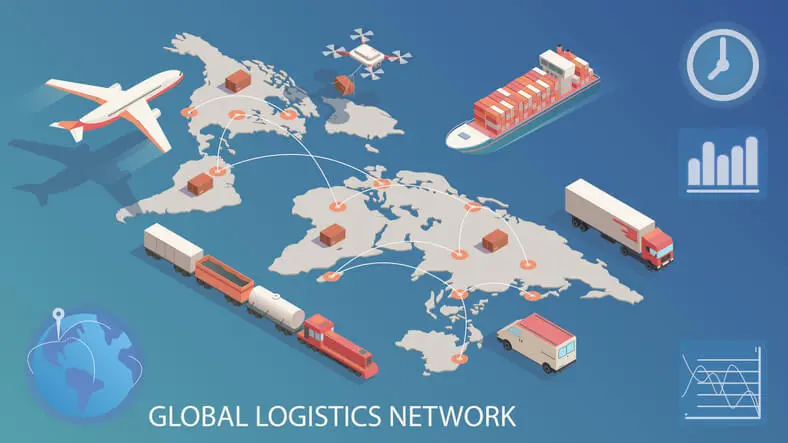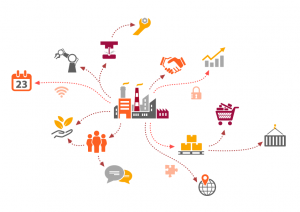A supply chain (SCM) management model serves as an invaluable tool, providing a structured framework for companies to effectively manage the flow of goods, services, and information from raw material suppliers to end consumers. A number of models, each offering a unique approach tailored to the specific business objectives, industries, or operational strategies, can be followed. If you believe that your company could benefit from a supply chain management model, then follow along as we explore the various existing supply chain models and their suitability for different scenarios.
Fundamentals of Supply Chain Models
Before delving into the intricacies of supply chain models, it’s essential to understand the key concepts and fundamental terminology of SCM. Supply chain management encompasses the coordination and integration of processes involved in procuring raw materials, transforming them into finished goods, and delivering those products to customers. Key components include demand forecasting, sourcing, production, inventory management, logistics, and distribution.
The Importance of Selecting the Appropriate Model
It is crucial that companies carefully evaluate their specific needs, industry dynamics, and business objectives in order to select the most suitable supply chain model, aligning with their goals and fostering a sustainable competitive advantage that will enable them to thrive in today’s competitive landscape. While an ill-fitted model can lead to inefficiencies, excess costs, and dissatisfied customers, the right model can streamline operations, reduce waste, and enhance profitability.
Types of Supply Chains
In order to select the most appropriate supply chain model, a good understanding of the various types is essential. Supply chains can be categorized according to various factors, such as the nature of the products, the production process, and the level of customer involvement.
Direct vs. Indirect
While a direct supply chain involves a straightforward flow of goods and services from the manufacturer to the end consumer, an indirect supply chain involves intermediaries, such as wholesalers, distributors, and retailers. As the direct model allows for greater control and efficiency, it is commonly used for products with high demand and low variability – often through a company-owned distribution channel. The indirect model, however, is suitable for products with varying demand patterns, or those requiring an extensive distribution network.
Lean vs. Agile
The lean supply chain model is well-suited to industries with stable demand and predictable supply, such as automotive manufacturing; focusing on eliminating waste and maximizing efficiency through continuous improvement and streamlined processes, while the agile supply chain model is ideal for industries with high product variability, short product life cycles, and unpredictable demand; prioritizing flexibility and responsiveness to rapidly changing market conditions. Where lean principles include just-in-time (JIT) production, continuous flow, and waste reduction, agile supply chains rely on real-time data, sharing, collaborative partnerships, and the ability to quickly adapt to shifts in customer preferences.
Push vs. Pull
In contrast to a push supply chain model which is driven by forecasted demand, a pull supply chain model is driven by actual customer orders. The push model approach is therefore suitable for industries with relatively stable and predictable demand patterns, such as consumer packaged goods while the pull model is particularly useful for industries with a high variable demand or customized products, such as electronics or fashion.
Green Supply Chain
The green supply chain model emphasizes environmental sustainability and eco-friendly practices throughout the entire supply chain process. It aims to minimize negative ecological impacts by reducing waste, optimizing resource utilization, and promoting the use of renewable and recyclable materials. Companies adopting this model often seek to establish a competitive advantage through their commitment to environmental responsibility and sustainable business practices.
Popular Supply Chain Models
While there are numerous supply chain models available, certain approaches have gained widespread popularity due to their proven effectiveness and adaptability across various industries. Let us explore some of the most commonly adopted supply chain models.
Continuous Flow
The continuous flow model is designed for mass production of standardized goods with consistent demand and is often employed in industries such as automotive manufacturing, where production lines are optimized for efficiency and economies of scale. It emphasizes the smooth and uninterrupted movement of materials and products through the supply chain, minimizing delays and bottlenecks.
Fast Chain
The fast chain model prioritizes speed and responsiveness to rapidly changing market trends and customer demands and is therefore particularly useful in industries with short product life cycles, such as fashion, electronics, or high-tech products. By minimizing lead times and fostering agility, fast-chain models enable companies to quickly introduce new products and capitalize on emerging market opportunities.
Efficient Chain
As the name suggests, the efficient chain model focuses on cost reduction and operational efficiency. It emphasizes lean practices, waste elimination, and the optimization of processes to achieve maximum productivity and profitability. This model is commonly adopted in industries with stable demand patterns and mature product lines, where cost control and process improvement are crucial for maintaining a competitive edge.
Agile
The agile supply chain model is designed to adapt swiftly to fluctuating customer demands and market conditions. It relies on close collaboration with suppliers and partners, real-time data sharing, and the ability to rapidly reconfigure processes and resources. This model is particularly well-suited for industries with high product variability where responsiveness to changing trends is paramount.
Custom Configuration
This model is commonly employed by industries such as automotive manufacturing as it enables the customization of products, allowing customers to choose various options and configurations in the final stages of the production process. Companies are able to maintain efficiency in the upstream supply chain while offering a wide range of customized products.
Flexible
The flexible model is particularly useful in industries with highly volatile demand, such as seasonal products or those heavily influenced by economic or environmental factors. It is designed to accommodate rapid changes in demand and supply patterns, emphasizing adaptability, scalability, and the ability to quickly reallocate resources and production capacities.
Supply Chain Management (SCM) Models
While supply chain models focus on the flow of goods and services, supply chain management (SCM) models provide frameworks and methodologies for optimizing and coordinating various supply chain activities. These models offer structured approaches to planning, executing, and monitoring supply chain processes, enabling businesses to achieve greater efficiency, responsiveness, and profitability.
Integrated Model
The integrated supply chain model aims to create a seamless flow of materials, information, and financial transactions, enabling greater visibility, responsiveness, and optimization of the overall supply chain. It promotes the sharing of information, resources, and decision-making processes, emphasizing collaboration and coordination among all members of the supply chain, including suppliers, manufacturers, distributors, and retailers.
SCOR Model (Supply Chain Operations Reference)
The Supply Chain Operations Reference (SCOR) model, consisting of five core processes: Plan, Source, Make, Deliver, and Return, is a widely adopted framework for analyzing and improving supply chain performance and provides a standardized approach to defining, measuring, and optimizing supply chain processes. It enables businesses to benchmark their supply chain operations against industry best practices, identify areas for improvement, and implement strategies to enhance overall supply chain effectiveness.
Just-In-Time (JIT) Model
The Just-In-Time (JIT) model is a lean manufacturing principle that aims to reduce inventory levels and improve operational efficiency by receiving materials and components only as they are needed for production. JIT relies on close coordination with suppliers, precise demand forecasting, and efficient logistics to minimize excess inventory and associated carrying costs. Waste is minimized, storage costs reduced and a continuous flow of goods through the supply chain is promoted.
Read more on the Just in time model in our dedicated article:
Mass Customization Model
The mass customization model combines the principles of mass production with the ability to customize products according to individual customer preferences. It leverages flexible manufacturing processes, modular product designs, and advanced supply chain management techniques to enable the cost-effective production of customized goods and services on a large scale. This model is particularly relevant in industries such as consumer electronics, automotive, and apparel, where customers demand personalized products without compromising on cost or delivery times.
Selection and Implementation of Supply Chain Models
Factors to Consider When Choosing a Model
Selecting the most appropriate supply chain model is a critical decision that can significantly impact a company’s operational efficiency, customer satisfaction, and profitability. Several key factors should be carefully evaluated when choosing a supply chain model. The industry characteristics and nature play a pivotal role in determining the most suitable model. This includes factors such as product types, demand patterns, and competitive landscape. The company size, available resources, and production capacities also play a significant role as some models may require substantial investments or infrastructure. Further factors are the product life cycle and demand variability. Whereas products with stable demand and long life cycles may benefit from efficient or continuous flow models, those with high variability and short life cycles may require agile or flexible approaches. Of course, a clear understanding of customer expectations, needs, and preferences, such as lead times, customization requirements, and service levels, is also essential when selecting a supply chain model, as is the geographical distribution of suppliers, manufacturing facilities, and customer markets.
Strategies for Effective Implementation
Implementing a new supply chain model is a complex undertaking that requires careful planning, execution, and ongoing monitoring. Several strategies may be followed to ensure effective implementation. A comprehensive analysis of the current supply chain operations will highlight areas for improvement and potential challenges in transitioning to the new model. Involving all relevant stakeholders, including suppliers, employees, and customers in the implementation process will allow for concerns or resistance to change to be addressed, in order to ensure ‘buy-in’. A comprehensive implementation plan must be in place, outlining the steps, timelines, and responsibilities for transitioning to the new model, including any necessary process changes, technology integrations, and staff training. Comprehensive training and education should be provided to all relevant personnel to ensure they understand the new processes, procedures, and technologies associated with the chosen supply chain model. The necessary technology systems and infrastructure to support the new model must be implemented. These would include factors such as enterprise resource planning (ERP), transportation management systems (TMS), or warehouse management systems (WMS). Clear performance metrics and key performance indicators (KPIs) should be defined from the outset to measure the effectiveness of the new supply chain model and identify areas for continuous improvement. Continuous monitoring of the implementation process is key. Lastly, any feedback received from stakeholders will allow for necessary adjustments to be made and to address any challenges or unforeseen issues that may arise.
Advantages and Challenges of Supply Chain Models
Although adopting an effective supply chain model can significantly enhance a company’s competitiveness, profitability, and customer satisfaction, the implementation and maintenance may also present various challenges.
Benefits of Effective Models
There are numerous advantages to implementing an appropriate, well-designed supply chain model. Overall operational efficiency and productivity can be significantly improved by streamlining processes, reducing waste, and optimizing resource utilization. Timely delivery, product availability, and the ability to meet customer expectations will enhance customer satisfaction. Models that emphasize lean practices, waste reduction, and inventory optimization can lead to substantial cost savings, improving profitability, while green supply chain models reduce the environmental impact of business operations and contribute to long-term sustainability. Agile and flexible models enable companies to quickly adapt to changing market conditions, customer demands, and disruptions, providing a competitive advantage in dynamic environments. By implementing contingency plans and diversifying supply sources, potential risks, such as supply disruptions, quality issues, or regulatory changes can be identified and mitigated.
Common Challenges and How to Address Them
Despite the numerous benefits, implementing and maintaining effective supply chain models can present various challenges that businesses must address. As supply chains become increasingly global and interconnected, managing the complexity of multiple tiers of suppliers, logistics networks, and regulatory requirements can be a significant challenge. Employing advanced technologies, such as supply chain management software and data analytics, can help businesses gain greater visibility and control over their supply chain operations. Effective supply chain management often requires collaboration and information sharing among multiple stakeholders. Establishing strong partnerships, fostering trust, and implementing robust communication channels are essential to overcome this challenge. Effective change in management strategies, including employee training, clear communication, and incentives, can help mitigate resistance to the implementation of a new model and the process changes and cultural shifts that it may involve, facilitating a smoother transition. Integrating various technology systems, such as enterprise resource planning (ERP), transportation management systems (TMS), and warehouse management systems (WMS), can be challenging due to compatibility issues and data silos. This can be addressed by adopting standardized data formats, interoperability protocols, and cloud-based solutions. Implementing robust risk management strategies, such as diversifying supply sources, maintaining contingency plans, and investing in supply chain resilience, can help businesses mitigate the impact of possible disruptions caused by various risks such as natural disasters, geopolitical conflicts, and cybersecurity threats. As the implementation and management of effective supply chain models often require specialized skills and expertise, investing in talent development, training programs, and collaborative partnerships with academic institutions or industry associations are important to address the supply chain talent gap. A proactive approach to challenges and continuous improvement in supply chain operations will allow businesses to maximize the benefits of their chosen supply chain models and maintain a competitive edge in their respective markets.
Future Trends in Supply Chain Models

Impact of Artificial Intelligence and Blockchain
Emerging technologies such as artificial intelligence (AI) and blockchain are poised to revolutionize supply chain models in the coming years. AI algorithms can analyze vast amounts of data from various sources to provide predictive insights, optimize supply chain processes, and enhance decision-making capabilities. Machine learning techniques can improve demand forecasting, inventory management, and route optimization, leading to increased efficiency and cost savings. Blockchain technology, with its decentralized and transparent nature, has the potential to transform supply chain traceability and transparency. By creating an immutable record of transactions and product movements, blockchain can enhance supply chain visibility, streamline documentation processes, and facilitate trust among supply chain partners. This technology can be particularly beneficial in industries with complex supply chains, such as food, pharmaceuticals, and luxury goods, where traceability and provenance are crucial.
Digitalization and Automation
The digitalization and automation of supply chain processes are becoming increasingly prevalent, driven by the need for greater efficiency, agility, and cost optimization. Digital technologies, such as the Internet of Things (IoT), advanced robotics, and autonomous vehicles, are enabling real-time monitoring, automated material handling, and optimized logistics operations. Automated warehouses, equipped with robotics and autonomous guided vehicles (AGVs), can significantly improve picking, packing, and inventory management processes, reducing labor costs and minimizing human error. Similarly, autonomous trucks and drones can revolutionize last-mile delivery, offering faster and more efficient transportation of goods. Furthermore, the integration of digital twins – virtual replicas of physical supply chain assets and processes – can facilitate simulations, scenario planning, and predictive maintenance, enabling proactive decision-making and minimizing downtime. As these technological advancements continue to evolve, supply chain models will need to adapt and leverage these capabilities to remain competitive and meet the ever-increasing demands of customers and stakeholders.
Why Supply Chain Planning Models are Important
In today’s globalized and highly competitive business environment, the effective management of supply chains has become a critical success factor for companies across industries. Selecting and implementing the appropriate supply chain model is crucial for achieving operational excellence, meeting customer expectations, and maintaining a sustainable competitive advantage. Supply chain planning models provide a structured framework for businesses to align their supply chain strategies with their overall business objectives. By carefully considering factors such as product characteristics, demand patterns, customer requirements, and market dynamics, companies can choose the most suitable supply chain model to optimize their operations, reduce costs, and enhance customer satisfaction. Moreover, supply chain planning models offer a roadmap for effective implementation, enabling businesses to navigate the complexities of supply chain transformation. They provide guidance on integrating technology, streamlining processes, and fostering collaboration among supply chain partners, ensuring a seamless transition to the new supply chain model. Effective supply chain planning models also facilitate risk mitigation and supply chain resilience. By incorporating contingency plans and leveraging advanced technologies like artificial intelligence and blockchain, businesses can proactively identify and mitigate potential disruptions, ensuring business continuity and maintaining a competitive edge.
In an increasingly globalized and interconnected world, supply chain management has become a strategic imperative for businesses. Adopting the appropriate supply chain planning model can drive operational efficiency, enhance customer satisfaction, and ultimately contribute to long-term profitability and sustainable growth.
Learn how Intuendi AI can improve your supply chain management.







